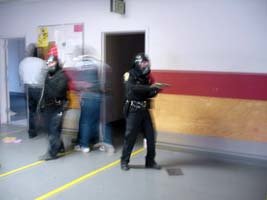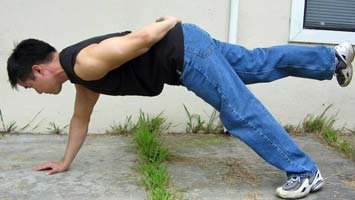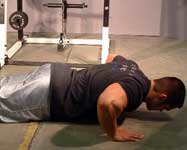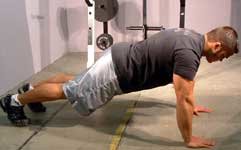There's a saying in police work: "I should have been a firefighter."
Whereas firefighters get paid to workout, sleep and eat three square meals at the firehouse, cops just don't get those fringe benefits. The combination of shift work, poor dietary habits, lack of exercise, and more can really take a toll on an officer's body. Before you know it, years go by. The officer makes detective, but he looks like Dennis Franz from NYPD Blue.
I train off-duty cops from time to time, but they don't have athletic or physique goals different from the general population. They usually ask for the same thing everybody else asks for:
"I want to be stronger."
"I need to lose this gut."
"I want to be one big bad@ss MOFO."
Cops are human just like everyone else, so they have the same vanities. When it comes down to it, most would rather look good than perform athletically. And yes, depending on your assignment or whatever call you get, police work can be an athletic event.

 Deadlifts:
Deadlifts:
If I'm training an officer to improve his or her physical performance at work, then I train the officer somewhat differently from regular Joe Citizen. For example, I always stress the importance of performing deadlifts.
You'd be surprised how often cops have to pick up a person lying on the ground. Usually it's some protester who wants to lay limp and do the "passive resister" strategy, but it could also be a drunk, an arrestee or a really heavy person that the EMT's need help putting on the gurney.

 Pullups:
Pullups:
The pullup is also relevant to police work. My other clients don't necessarily need to do pullups, but cops do. The pullup really works and strengthens the back muscles, particularly the lats. When cops chase crooks down an alleyway and have to climb a fence, they essentially have to do a pullup. When SWAT guys rappel down the side of a building, they need lat strength and the pullup develops lat strength in spades.
The pullup is also great for developing grip strength. After all, you have to hang on and pull your bodyweight. Grip strength is very important in law enforcement. When a cop handles a firearm (whether it be a sidearm or shotgun), he needs a certain amount of both grip and lat strength. Grip strength also comes into play when an officer has to grapple with a suspect and subdue him.
Unfortunately, most police officers cannot do a pullup. And of those that can do pullups, few can do a pullup with all of their gear on.

 Pushups:
Pushups:
What's worse is the way recruits are trained in most academies does not prepare them for the physical demands of the street. Frankly, I really despise the way police recruits are physically trained in academies. It's completely @ss-backwards. Most academies have no weight rooms, let alone strength programs.
They make these young recruits run and run and run and do thousands of pushups. High rep pushups develop NO strength relevant to our line of work. None.

 Endurance:
Endurance:
And with regards to running: when you're out in the street and chase a suspect, you'll more than likely have to sprint. It's about speed. You ain't going to be running for miles. That's what the patrol car's for. That's why you have a radio to tell your backup, "He's coming your way!"
All that endurance training, with the running and calisthenics, really just takes away from an officer's strength, speed, and power. In the cop world, strength, speed, and power are what counts. That's how you end confrontations and chases quickly. As they say in the world of athletics (and in the world of illegal narcotics), "Speed kills."
Now, to a certain extent you need endurance. But for cops, we're talking about strength endurance. We're talking about maintaining your strength for an extended period of time, such as wrestling with a suspect. But these "long" wrestling matches typically don't last more than a few minutes. If the bout did last longer, then I'd say the officer needs to brush up on his groundfighting.
| RELATED ARTICLE | ||
|
If you want to develop strength endurance in a cop, then he'll need to incorporate that element into his skills training. It has to be very specific to the job, though.
For example, what is typically done at academies is to have a recruit trainee sprint up a hill as fast as possible and then have the recruit subdue and handcuff a pretend suspect waiting at the top of the hill. You'll find that a cop's fine motor skills deteriorate after a "balls to the walls" chase, despite having practiced his defensive tactics (DT) skills on the mat a thousand times before.
| RELATED ARTICLE | |||
|
Author: Charles Staley |
If you have a trainee regularly practice his DT skills after an explosive bout of physical stress (i.e. sprinting up a hill), then the trainee learns to work through fatigue. That's a far better way of developing strength endurance specific to law enforcement. Not running for half a mile or more.

Strength Training And "Officer Presence"
I got asked by a reader of my blog if one could develop strength and aesthetics as a law enforcement officer (LEO). My answer: most definitely!
In fact the aesthetics required to look good in a uniform are very similar to the classical bodybuilder look of olden days: wide shoulders and back, strong massive arms, trim waist. This of course is the cherished V-tapered physique.
Related V-Taper Articles:
An officer's uniform and equipment cover up much of his or her body. So the only real visual impression you can make with your physique is how wide you appear in the shoulders, back and upper arms and how thick and strong your forearms look (if you wear short sleeves). Don't worry about too much about upper body thickness, because the vest will make you look thick anyway.
To make your shoulders and back look wide, you'll need to develop them, but also contrast them with a small waist. Your gun belt will thicken the look of your waist already, so try to keep the waist line down.
And although your legs should be strong and powerful, quick and agile, they should also be long and toned, not wide and thick. Do a lot of back squats, leg presses, and lunges, and you will thicken your hips and @ss. Front squats and Hack squats are better. A thick @ss and hips doesn't look or feel good in straight legged polyester slacks: too much chafing when you run, walk or sit.
Develop this look, and you will have "command presence" in a uniform. It also looks great without a uniform, too, by the way. The classical bodybuilding aesthetic is ideal for patrol officers and SWAT, because it is also functional. A cop has to be lightweight and agile, but strong and powerful to chase and subdue dangerous criminals.
Related Police & Military Articles:
The only LEO's I don't recommend this look for are those in the jails and prisons. In those environments, a deputy or officer needs to be as physically intimidating as possible. Lightweight agility is not needed as much in such confined spaces. If you're a correctional officer or sheriff's deputy, then take up powerlifting instead.

The Workout
Here is a training program that develops not only the strength needed for the job, but also develops a classical V-taper. One word on strength development, however: it should not be a complete substitute for your takedown skills or for your brains out in the field. This is a strength building workout, nothing more. It does not make you Batman or Superman.
Strength should be respected, but you need to direct it through proper technique and skill and a good head on your shoulders. Strength is like having a high caliber firearm: what use is it if you can't aim right?
With that being said, here's the program:

Week 1 & 2 (Density)
- Wide-grip pullups (overhand grip) to failure, rest 10 seconds.
- Medium-grip pullups to failure, rest 10 seconds.
- Medium-grip chin-ups (underhand grip) to failure, rest 10 seconds.
- Narrow-grip chin-ups to failure.
Workout #1:
A) Quads Triset
A1) Front squats, 6-8 reps, rest 10 seconds
A2) Back squats, heels raised (same weight as front squats), as many reps as possible (AMRAP), rest 10 seconds
A3) Sissy squats, body weight only, AMRAP
Rest three minutes, and then repeat the entire process two more times.
B) The Gymnast's Routine
Here's a giant set of pullup variations that will blast every fiber of the back:
C) Wide-grip upright barbell rows, 4 sets, 12-15 reps, 1 minute rest
D) Biceps/Brachialis Compound Set
D1) Zottman curls, 6-8 reps, rest 10 seconds
D2) Lying dumbbell curls, 10-12 reps
Rest two minutes, and then repeat the entire process two more times.
E) Dips, bodyweight only, 3 sets, AMRAP, 1 minute rest
Workout #2:
High intensity interval training (HIIT), 20 minutes (90 seconds walk, 30 second sprints)
Workout #3:
A) Hang cleans, 6 sets, 4-6 reps, 90 seconds rest
B) Snatch grip deadlifts, 6 sets, 4-6 reps, 90 seconds rest
C1) reverse grip barbell curls, 4 sets, 4-6 reps, 90 seconds rest
C2) Lying barbell triceps extensions, 4 sets, 4-6 reps, 90 seconds rest
D) Swings, 3 sets, 10-12 reps, 1 minute rest
Workout #4:
HIIT - 20 minutes (Farmer's walks for 30 seconds, walk with no weight for 90 seconds)

Weeks 4 & 5 (Decompression)
Workout #1:
A) pullups, 4 sets, AMRAP, 3 minutes rest
B) Barbell military press, 4 sets, 6-8 reps, 3 minutes rest
C) deadlifts, 4 sets, 4-6 reps, 3 minutes rest
Workout #2:
A) pullups, 4 sets, AMRAP, 3 minutes rest
B) Close-grip bench press, 4 sets, 5-7 reps, 3 minutes rest
C) Barbell Hack squats, 4 sets, 4-6 reps, 3 minutes rest
Workout #3:
A) Pullups, 4 sets, AMRAP, 3 minutes rest
B) Weighted dips, 4 sets, 4-6 reps, 3 minutes rest
C) Front squats, 4 sets, 3-5 reps, 3 minutes rest

 Additional Program Notes:
Additional Program Notes: 
You'll decide what days to take off, as long as you complete the rotation of workouts before the end of each week.
Whether you want additional strength and physical presence for patrol or just look like Ponch from CHiP's, give this workout a try.
About The Author:
James Chan is a police officer for the University of California Police Department in San Francisco. When he's off-duty, James conducts personal training, specializing in strength and physique enhancement. He is certified through the National Strength and Conditioning Association and may be reached at jchan@strengthandphysique.com.













